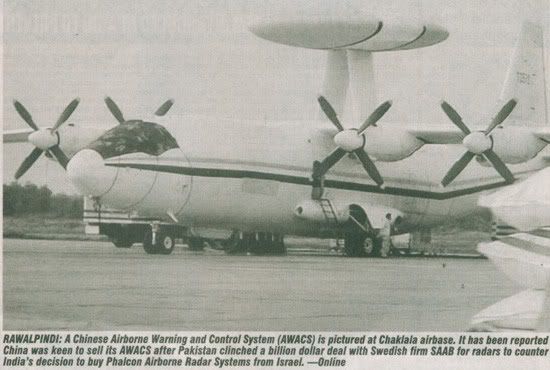
Now that is very interesting. PAF is gonna have Western and Chinese AWACs. I t think the PAF will probably buy up to three Chinese AWACs. Just wondering: what is the estimated price on these aircraft?

lol, what gave you the impression that electronics outfit of the Saab system is decades ahead of its Chinese counterpart. In one interview with a KJ-2000 developer, it was mentionned that KJ-2000 uses the latest available COTS product. In another interview, a KJ-2000 radar expert claimed that KJ-2000 is the most advanced AWACS in the world. Now, I don't agree with that, but this is not something he would say if the system is decades behind the most advanced AWACS in the world, right?PakTopGun said:as far as im aware the PAF is only reviewing the aircraft and will consider it should the Saab deal fall through. THe electronics outfit of the Saab system is decades ahead of its chinese counterpart. But still, this is a vital area of concern for the Pakistan airforce which needs to fill in the gap of airborne surveillance/control urgently so all options are to be investigated. I think the Swedish deal will be more than enough to fullfill the PAF requirements I think. anyhow, will try to find out more on this issue soon!
tphuang said:lol, what gave you the impression that electronics outfit of the Saab system is decades ahead of its Chinese counterpart. In one interview with a KJ-2000 developer, it was mentionned that KJ-2000 uses the latest available COTS product. In another interview, a KJ-2000 radar expert claimed that KJ-2000 is the most advanced AWACS in the world. Now, I don't agree with that, but this is not something he would say if the system is decades behind the most advanced AWACS in the world, right?
As for this Y-8 AEW, it's not using AESA radar, so I would agree that it's not as advanced as Erieye. But to say that because something is Chinese, then it is backward is just ridiculous.
sumdud said:I don't really get it: If Pakistan decides to get this plane, what will be the advantage? They are getting Erieyes already.
maglomanic said:1) Sanction proof, West tends to impose those at the drop of a hat (ofcourse unless you are Israel).
2)Better integration with Chinese systems (C4I,J-10,JF-17 etc).
3)Cost. China is always generous with Pakistan when it comes to costs (soft long term loans).
4)Better Chances of customization,upgrades and technology transfer.(some examples are JF-17, Al-Khaled tanks, Red Arrow ATGMs, F-22 P frigates and the list goes on).
PakTopGun said:agreed. I never really considered you point #2, will it be that difficult to integrate the Saab system to work with Pakistans Chinese systems? I just assumed that it would be quite straight forward
I don't think it's that easy. If you think about Link 16 as a networking standard with a certain send and receive protocols. It seems information in a certain way using certain data formats. And then, you have the Chinese receiving end, designed to receive different data formats and anticipate different ways that the data will arrive.maglomanic said:It is very much doable and will be done. My point is , it will be more effective with Chinese systems. It's like you can make a Mac and PC talk together but still you need a layer of protocol software that sits on top of the differences in hardware. If both your AWACS and fighters are from one source then you can rest assured that their datalink and communications has been optimized. Incase of integrating two systems from different sources optimization needs to be done and how much optimization could be done would be an unknown. But i am pretty sure both systems pretty much adhere to international standards (link 16) and could be integrated without too much hassle.
tphuang said:I don't think it's that easy. If you think about Link 16 as a networking standard with a certain send and receive protocols. It seems information in a certain way using certain data formats. And then, you have the Chinese receiving end, designed to receive different data formats and anticipate different ways that the data will arrive.
For example, network type 1's protocol involves, sending 1 message to the receiver, wait for receiver to send the confirmation back before sending the 2nd message.
Network type 2's protocol involves, sending 1 message to the receiver, wait for receiver to send that it received it and then sender will send another confirmation to tell receiver that it got its confirmation before sending the 2nd message.
That's just a simple example. If sender is using network type 1 and receiver is using network type 2. You can see how much difficulty it would be for this to systems to link together. If both sides are using network type 1 or both using type 2, then you can guarantee that they are working as the original design was intended. Their original jam-resistance, secure and LPI properties should all be maintained from this.
There is no indication that China uses Link 16.
